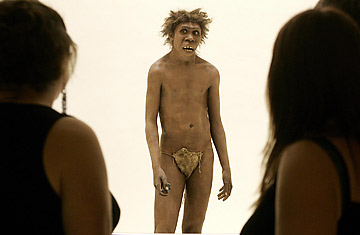
Tourists visiting the Museum for Prehistory in Eyzies-de-Tayac look at a Neanderthal man
(2 of 2)
Still, other paleoanthropologists say the discovery is not entirely unexpected. There is ample archaeological evidence — including tools, habitation sites and fossils — that Neanderthals and early modern humans may have coexisted in the Middle East as much as 80,000 years ago, and certainly in Europe 30,000 to 45,000 years ago. What has been missing until now is the genetic evidence.
"The fact that they found it across the board says that the evidence must be very widespread across modern humans," says Erik Trinkaus, an anthropologist at Washington University in St. Louis, Mo., who has long argued that the human fossils he has studied in France, Romania, the Czech Republic and other places show mixed ancestry. "If you can find evidence [of Neanderthals] after 30,000 years of [human] genetic shifting, then it must have been pretty important or prominent then." Trinkaus speculates that the genetic flow between Neanderthals and early modern humans might have been as high as 10% to 20%.
The new finding may prompt a tweaking of the well-known Out of Africa theory, which in its strictest interpretation says a small group of early modern humans left Africa and outcompeted and replaced all other hominids without any interbreeding. The alternate theory, known as multiregionalism, argues that distinct populations of modern humans developed simultaneously around the world and along the same evolutionary lines by swapping genes.
"What we falsify here is the very hard Out of Africa theory," said Pääbo. "We show that outside Africa there is this 1% to 4% that came from archaic humans. Of course, it's totally possible that archaic forms that we don't know contributed to Africans today. I don't think we should take this as evidence that only people outside Africa have some 'caveman' biology within them."
According to Trinkaus, many paleoanthropologists have long believed that early modern humans and Neanderthals interbred. "People have been saying this for decades," he argues. "The minority position was the position that there was no gene flow. Most people who work with the fossil record support some level of admixture."
Whatever our mixing, it is human uniqueness that has also been revealed by the sequencing. By comparing the Neanderthal genome with those of modern humans, the team identified a small number of genetic changes that were newly evolved in modern humans. Some of the changes may have arisen as a result of genetic drift, but others seem to have been positively selected for — meaning they swept through populations rapidly, possibly because they gave us some advantage.
The genes in which some of the changes occurred play a role in cognitive and physical development — such as cranial features, skin pigmentation and how we metabolize energy. The study's authors don't yet know what the specific changes signify, but in living people, mutations in some of the genes related to cognitive development contribute to conditions such as Down syndrome, schizophrenia and autism.
Despite the lingering questions, the sequencing of the genome is itself a triumph. "Sequencing ancient human DNA is extremely difficult," says computational biologist Webb Miller, part of a Penn State team that sequenced the genome of a woolly mammoth in 2008 — the first such analysis of an extinct animal. (For this achievement, Miller and colleague Stephan Schuster were included among the TIME 100 honorees in 2009.)
While his own work was a technological breakthrough, "what they did was harder," Miller says. "We were working with a frozen sample, so we could get a lot more DNA from the sample. What they did technically was extremely difficult and full of land mines. And I hope they didn't hit any."
Miller adds, "This is a way cool paper. I think it's really fascinating. Some [scientists] will love it, and some of them will hate it. It's great science."
The original version of this article misstated that computational biologist Webb Miller decoded the genome of the 5,300-year-old mummy "Otzi the Iceman."
